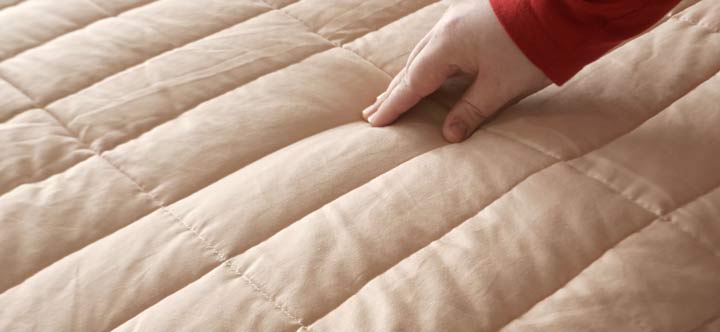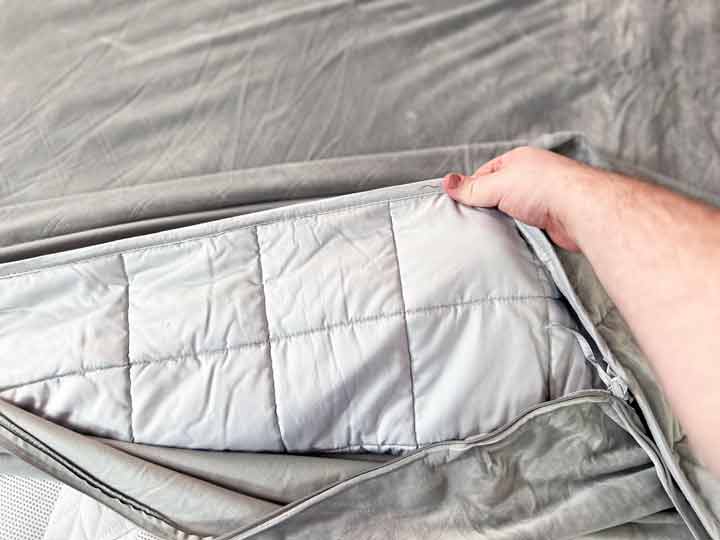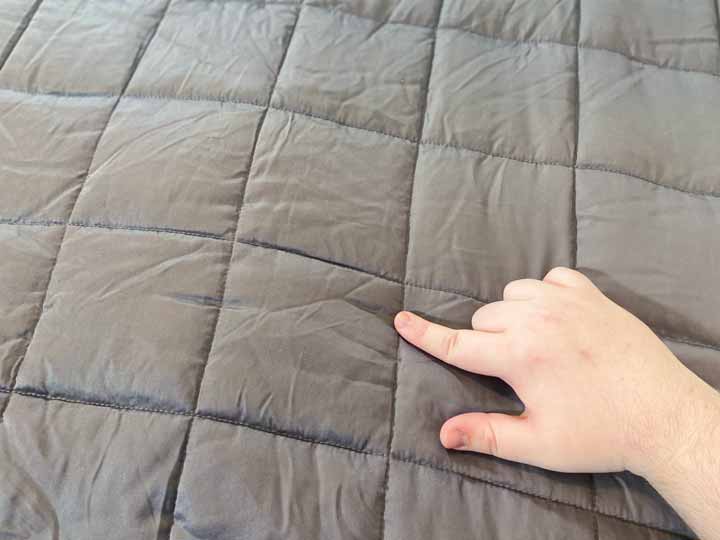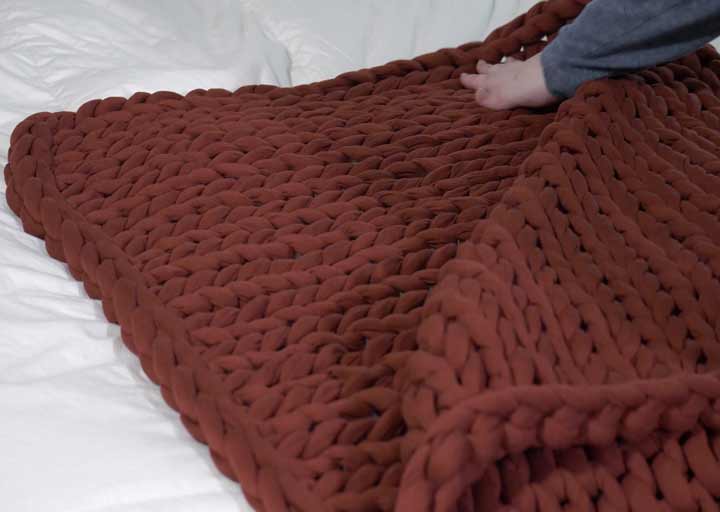Weighted blankets are an accessory many reach for for a variety of reasons, such as reducing anxiety or needing extra warmth. But for those who are new to weighted blankets and turn to reviews to help out, it’s important to know what to expect.
Here at Mattress Clarity, testing a weighted blanket might look like simply curling up underneath one, but it goes a little deeper than that. We’ve taken the time to explain exactly what we assess each weighted blanket for, so keep reading to see.
What We Look for in Weighted Blankets
Weighted blankets come in a variety of forms and use just as much variety when it comes to materials. The most basic weighted blanket will consist of a fabric shell and a loose inner fill to give it its weight. Others will have a weighted insert that goes inside an outer cover, while some even have a chunky knit design.
Regardless of its design, there are six main categories that we assess for weighted blankets. Four of these categories deal with the design, while the other two categories deal with temperature regulation and the durability of the blanket. I’ll break down each category below.
Outer Shell Material
The outer shell can mean different things depending on the weighted blanket type. For those that utilize the weighted insert/duvet cover design, we mostly will refer to the duvet cover in our review, as that’s what most people will feel most of the time.

Outer shell materials can vary from cotton, polyester, bamboo, or TENCEL. These will all have different feels and can influence the price as well. Polyester, being a synthetic material, will cost less than cotton, bamboo, or TENCEL fabrics. These materials are also very common to see in the chunky knit weighted blankets.
Inside Fill Material
Many weighted blankets we’ve tested have glass microbeads as their inner fill. This gives the blanket its weight. In our experience, glass beads seem to be the industry standard, though materials like plastic pellets and sand have been used as well.

Chunky knit weighted blankets, for the most part, will use doubled up fabric, and do not have an inner fill to give them their weight. Though there are instances of knit weighted blankets using thick down alternative fluff to give it its weight.
Overall, the fill material should be rather quiet and smooth and should make for a pleasurable experience.
Weight Options
The weight range for weighted blankets is quite expansive. We’ve seen weighted blankets go as low as 5 lbs, and as high as 35 lbs. The more weight options a brand provides, the more accessible that blanket is to a wider range of people.
Some brands we’ve tested have only had one or two weight options, which appeals more towards more average weight adults. I’ll discuss how to pick the right weight for a weighted blanket below.
While weight options aren’t something we will score weighted blankets for, it’s worth pointing out here. Some people prefer heavy weighted blankets while others prefer something that they know will fit their body and preferences. And depending on the brand, weight options will likely have price variations as well.
Weight Distribution
Weight distribution refers to how evenly the weight feels across your whole body. Usually, there’s some construction detail that helps the weight from clumping in one side or a corner of the blanket. This typically looks like the weighted blanket (or insert if you have a duvet cover) being sewn through with a box or grid design.

With so many squares, the weight can lay flat and even across your body. Chunky knit weighted blankets usually have great distribution as they don’t use a sand or glass filling. Generally, weighted blanket designs have been perfected when it comes to weight distribution. Most blankets we’ve tested have scored high in this category, but it’s still a category worth testing.
Temperature Regulation
By nature, weighted blankets are going to add some additional warmth. They’re thick and the fills can sometimes prevent airflow. But, we still assess weighted blankets for how well they can regulate temperature.
We usually do this by examining what materials are used to make up the outer layers of the blanket. Polyester usually isn’t going to be the best at airflow, but it’s going to be great for insulation, especially if it’s that minky, slightly fuzzy type of polyester.
Cotton, bamboo, and TENCEL are better for hot sleepers who want a weighted blanket, but don’t want to worry about overheating. Cotton is very breathable, and bamboo and TENCELare both breathable and moisture-wicking, meaning you shouldn’t feel that hot and sweaty.
Chunky knit blankets are naturally going to be better for hot sleepers because they can open up and let air flow through. Many of the best cooling weighted blankets will feature a knit design, or use bamboo or TENCEL in their construction.

Blankets that feature the chunky knit design, or have bamboo or TENCEL in their construction do tend to score higher on temperature regulation. The blankets that don’t feature any cooling materials, or are just intended for colder weather tend to get more average scores in this category.
Durability
The last thing we look for in weighted blankets is durability. The blankets that utilize the duvet cover and weighted insert design are usually the most long lasting. Just like comforters and duvet inserts, the outer cover can help protect the weighted insert. We’ll usually rate these types of weighted blankets high on durability.
Materials also play a role in durability. Polyester might not be as long lasting as its natural counterparts bamboo, cotton, or TENCEL. But care instructions and the ability to be washed will also play a role in durability as well. Blankets that have some element of machine-washing tend to score higher because of the convenience factor over spot cleaning.
How Do I Know What Weight is Best for Me?
Here at Mattress Clarity, we make sure to include how to pick the best weighted blanket in many places, such as our Best Weighted Blankets list, and we give a quick mention of it in each of our individual reviews as well. But, just as a quick recap, the best weighted blanket will be what feels best to you.
But if you’re looking for a hard number, a good starting point is to take 10% of your body weight (divide your body weight by 10), add or take away a pound or two, and that’ll be the ideal weight for you. We’ve made it easy with a weighted blanket calculator, a tool where you can also find more information about finding the right weight selection.
Weighted Blanket Care
Brands will always include how to best take care of your weighted blanket. Some weighted blankets can be fully machine-washed, while others might recommend only removing the outer cover and washing that. Some might be spot-clean only. There will usually be a card or some form of instructions on the blanket itself that will show you how to clean it, so be sure to read that thoroughly.
If the blanket doesn’t have care instructions in its packaging or on the blanket, the brand’s website should provide care instructions. If you can’t find it online, you’ll have to contact customer support. There have been moments where we’ve had to use chatbots to confirm care instructions, but it’s usually quick and easy to do so.
It’s also worth pointing out that weighted blankets have the potential to ruin washing machines and dryers because they are so heavy. This is why paying close attention to the care instructions is so important. If a weighted blanket isn’t recommended to be machine-washed, you should never do so and spot clean it only.
Who Shouldn’t Use a Weighted Blanket
Generally speaking, most people are safe to use weighted blankets without much concern, or any need to consult their doctor. People who shouldn’t use weighted blankets include:
- Toddlers & babies: Weighted blankets will be too heavy for them. Given the 10% rule, children around the 50 lb mark should be safe to use the lightest weighted blanket we’ve encountered, which is 5 lbs.
- People who can’t lift the blanket: Not everyone has the strength to lift a weighted blanket, especially when some get as heavy as 25 lbs and more.
- Those with sleep apnea: If you’re a back sleeper who deals with sleep apnea and doesn’t have a CPAP machine, a weighted blanket might make it easier for your airways to collapse while you sleep. At any rate, please consult your healthcare provider if you have sleep apnea and are looking into getting a weighted blanket.
On the other hand, there is evidence that suggests those with anxiety, autism, or high levels of stress could see positive benefits from using weighted blankets. While not definitive, many have expressed that they feel calmer while using weighted blankets.

